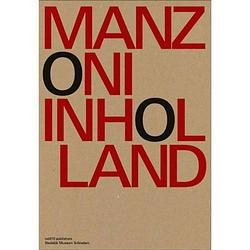Manzoni In Holland
Product informatie
Product tijdelijk niet beschikbaar
0 van de 5 sterren
0 reviews

For English, please see below Als een van de grootste wegbereiders van de internationale conceptuele kunst onderhield de Italiaanse kunstenaar Piero Manzoni (1933-1963) een bijzondere band met Nederland. Nu zijn intensieve correspondentie met de Rotterdamse galeriehouder Hans Sonnenberg voor het eerst toegankelijk is gemaakt, wordt de omvang van Manzoni's invloed op de naoorlogse avant-garde in Nederland zichtbaar. Gedurende zijn korte kunstenaarscarrière vervaardigde Piero Manzoni meer dan duizend doeken, sculpturen en andere objecten. De conventionele kaders van het kunstwerk werden door hem op radicale wijze doorbroken, waarbij zelfs het lichaam van de kunstenaar onderdeel werd van het werk. Daartegenover staan zijn Achromes, letterlijk: 'zonder kleur'. Het oppervlak van het schilderij werd bij Manzoni een ruimte voor onbegrensde mogelijkheden. Het bood niet langer plaats aan de illusie van de geschilderde voorstelling of het persoonlijke expressieve gebaar van de kunstenaar, maar werd een op zichzelf staande entiteit. Het werk van Manzoni was van grote invloed op de Nederlandse nul- en internationale ZERO-kunstenaars. Manzoni in Holland is een nog niet eerder verteld verhaal over de bijzondere relatie van een van de meest prominente avant-gardekunstenaars van de twintigste eeuw met Nederland. -- As one of the greatest pioneers of international conceptual art, Italian artist Piero Manzoni (1933-1963) maintained strong ties with the Netherlands. The unlocking of his intensive correspondence with Rotterdam gallery owner Hans Sonnenberg has revealed the extent of Manzoni's influence on the post-war avant-garde in the Netherlands. During his short artistic career Piero Manzoni produced more than a thousand canvases, sculptures and other objects. He radically rejected the conventional context of the work of art, even integrating the body of the artist in the work. He also created so-called Achromes, literally: 'without colour.' Manzoni considered the surface of the canvas to be a space of unlimited possibilities. It no longer accommodated the illusion of the painted representation, or the artist's personal expressive gesture, but it became an autonomous entity instead. Manzoni's work was of great influence on artists associated with the Dutch nul-groep and the international ZERO movement. Manzoni in Holland is the untold story of the special relationship that one of the most prominent avant-garde artists of the twentieth century had with the Netherlands.






